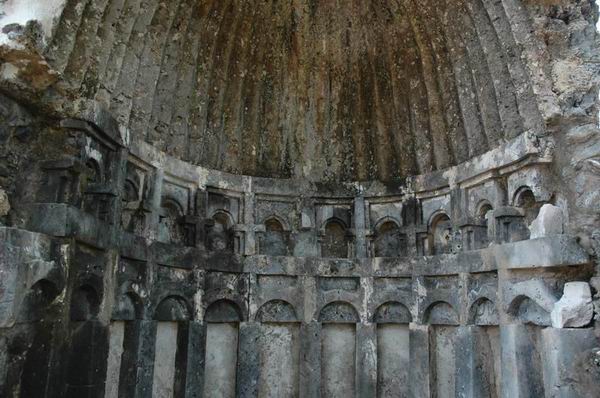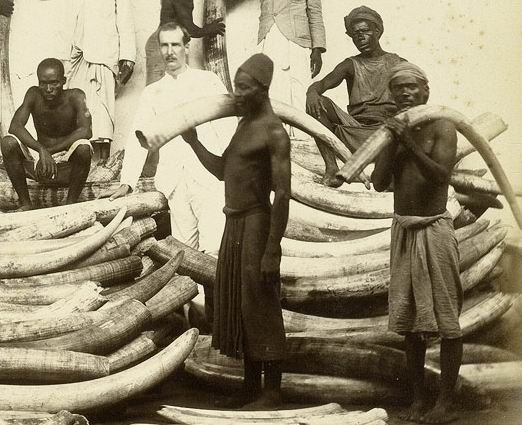


Notice: This is the official website of the All Empires History Community (Reg. 10 Feb 2002)
Ancient Persian Empires in Southeastern Africa |
Post Reply 
|
| Author | |
Cyrus Shahmiri 
Administrator 

King of Kings Joined: 07-Aug-2004 Location: Iran Online Status: Offline Posts: 6240 |
 Quote Quote  Reply Reply
 Topic: Ancient Persian Empires in Southeastern Africa Topic: Ancient Persian Empires in Southeastern AfricaPosted: 29-Oct-2009 at 02:50 |
|
Madagascar and Comoros islands have a several centuries-long Persian presence but a Persian empire's center of power was first formed in Kilwa in Modern Tanzania:
 We know some people from Shiraz, the capital of Persia province of Iran, migrated to this region and found great Zanj Empire in the 10th century: http://en.wikipedia.org/wiki/Zanj_Empire Afro-Shirazi Party is still one of the most important eastern African political organizations: http://en.wikipedia.org/wiki/Afro-Shirazi_Party
But before them another people from Iran went there and found Kilwa Empire: http://en.wikipedia.org/wiki/Kilwa_Empire
The Kilwa Empire was part of a larger empire built by the Bazrangids. It became an independent geopolitical entity after Ardashir I of the Sassanid Empire conquered its parent Bazrangi state in southern Persia in 224 AD. Emperor Ardashir's successor, Shapur I, annexed the southern shores of the Persian Gulf, as well as the region of Muscat on the Indian Ocean. This led to the removal of all final vestiges of Bazrangi independence on the Asian continent.
Zoroastrian fire temples within the Kilwa Empire were preserved as a result of Bazrangi custodians. Sassanian sources, which include rock inscriptions and documents, discuss how the Bazrangids served important custodial functions at the Great Temple of the goddess Anahita in Istakhr (near Persepolis). The Kilwa Empire prospered even during the early Islamic era. However, the capital city of Kilwa was under siege by members of the native populations of East Africa. The city fell and nearly 2000 of its inhabitants were devoured in a single week. In 980 AD, the Zanj Empire was founded by Ali ibn Hasan and succeeded the Kilwa Empire. Recent archaeological excavations in the old Kilwa imperial sites such as Unguja Ukuu, Tumbatu, Mtambwe, and Mkumbuu are shedding new light on the history of the Bazrangid founded Kilwa Empire and its status as a maritime power. And about Bazrangids: http://en.wikipedia.org/wiki/Bazrangids
The Bazrangids (also known as Bazrangi or Badhrangids) were an ancient mountain-dwelling Iranian tribe that established a maritime empire outside the Iranian plateau. Their first major overseas possession entailed Mazun (present-day Oman) and the port of Suhar became the region's capital. By the end of the 1st century BC, most of the islands of East Africa were annexed by the Bazrangids. These islands entailed Zanzibar, Pemba, Mafia, Combolo/Comoros and Madagascar.
Ruins of Ancient Kilwa, Tanzania, UNESCO World Heritage Site: http://whc.unesco.org/en/list/144/gallery/
            |
|

|
|
 |
|
opuslola 
Tsar 
suspended Joined: 23-Sep-2009 Location: Long Beach, MS, Online Status: Offline Posts: 4620 |
 Quote Quote  Reply Reply
 Posted: 29-Oct-2009 at 15:23 Posted: 29-Oct-2009 at 15:23 |
|
Cyrus, what a beautiful site! Indeed one can see what appears to be typical Iranian architure in the photos!
But, accordingly this part of your post which is from Wikipeda says; "And about Bazrangids: http://en.wikipedia.org/wiki/Bazrangids The Bazrangids (also known as Bazrangi or Badhrangids) were an ancient mountain-dwelling Iranian tribe that established a maritime empire outside the Iranian plateau. Their first major overseas possession entailed Mazun (present-day Oman) and the port of Suhar became the region's capital. By the end of the 1st century BC, most of the islands of East Africa were annexed by the Bazrangids. These islands entailed Zanzibar, Pemba, Mafia, Combolo/Comoros and Madagascar." You must understand that I am sometimes confused by statements like we see above! These people, who it seems were from a "mountain-dwelling Iranian tribe" almost always makes me cringe! Just how does such a tribe move from the mountains to the sea coast and become a great sea-going tribe? There had to be some major transformation for this to happen, but we see, it seems, to happen quite often! I, for one, have problems which such a major change in the very nature of a tribe or people! Sea-faring seems to have been a way of life that required a great deal of past experience to become proficient with? But, as I have said many times, I could be wrong? |
|
|
http://www.quotationspage.com/subjects/history/
|
|
 |
|
Sander 
AE Moderator 
Joined: 20-Mar-2007 Location: Netherlands Online Status: Offline Posts: 597 |
 Quote Quote  Reply Reply
 Posted: 29-Oct-2009 at 20:45 Posted: 29-Oct-2009 at 20:45 |
|
An important Persian presence at the East African coast ( commercial/ political ) since the mid /end of the first milenium AD is well attested by many means. ( historical records, archaeological findings etc. ) It's also known dat Zanj/Zenj is a Persian word in origin, usually applied to the darks locals . Edited by Sander - 29-Oct-2009 at 21:32 |
|
 |
|
Cyrus Shahmiri 
Administrator 

King of Kings Joined: 07-Aug-2004 Location: Iran Online Status: Offline Posts: 6240 |
 Quote Quote  Reply Reply
 Posted: 30-Oct-2009 at 04:13 Posted: 30-Oct-2009 at 04:13 |
|
I also have some doubts about the Bazrangids and other mass migrations from Persia to these regions before the tenth century, in fact I think migration order could be in reverse, it was very possible that Balcks were called "badh-rangi" (ugly/bad colored) by Persians, of course it sounds insultive, it could be the same word which has already been changed to "Barzangi" (ulgy black), if you search for "Like a Barzangi" in google then you will find this article in JStor: "The Negative Images of Blacks in Some Medieval Iranian Writings".
Anyway as I said in this thread:
"The Oriental Ethiopians have their hair straight; those of Africa have their hair more crisp and curling than any other men.", Herodotus
This man was our local guide in the ancient Elamite Ziggurat of Chogha Zanbil near Susa:
Edited by Cyrus Shahmiri - 30-Oct-2009 at 04:15 |
|

|
|
 |
|
Cyrus Shahmiri 
Administrator 

King of Kings Joined: 07-Aug-2004 Location: Iran Online Status: Offline Posts: 6240 |
 Quote Quote  Reply Reply
 Posted: 30-Oct-2009 at 08:00 Posted: 30-Oct-2009 at 08:00 |
|
Of course it is good read what African themselves say about it:
Mwaka kogwa Festival:
  |
|

|
|
 |
|
Sander 
AE Moderator 
Joined: 20-Mar-2007 Location: Netherlands Online Status: Offline Posts: 597 |
 Quote Quote  Reply Reply
 Posted: 05-Nov-2009 at 19:55 Posted: 05-Nov-2009 at 19:55 |
|
I ve read the paper. I noticed that the author states :
"By the time Alexander attacked Iran, Ethiopia was part of the Achaemenian Empire. This expansionist interest was not one-sided. Black encroachment on the Persian Gulf coast"compelled the Parthians to lead a military expedition intoMozun and Ethiopia...and to force the blacks to retreat to Africa through Hadrmut, Yemen, and the Strait of Bab el-Mendeb."5 ( Southgate 1984 : 5)
From what I ve read so far; Cambyses was not that succesful in Ethiopia . Are there other grounds for including Ethiopia ( probably meaning Kush/ Nubia ) in the empire around Alexander's time ? Edited by Sander - 05-Nov-2009 at 19:59 |
|
 |
|
Cyrus Shahmiri 
Administrator 

King of Kings Joined: 07-Aug-2004 Location: Iran Online Status: Offline Posts: 6240 |
 Quote Quote  Reply Reply
 Posted: 06-Nov-2009 at 11:56 Posted: 06-Nov-2009 at 11:56 |
|
Ethiopia was certainly part of the Persian Achaemenid empire, we read in one of inscriptions of Darius the Great at Persepolis (DPh): "Darius the King says: This is the empire which I hold, from the Scythians who are beyond Sogdiana, thence to Ethiopia", he says in another inscription at Susa (DSf): "The ivory which was wrought here, was brought from Ethiopia" and Artaxerxes III, one of the last Achaemenid kings, in his inscription at Persepolis (AIIIP) about throne bearers representing the thirty nations of the empire says: "28. This is the Ethiopian". Persepolis - Apadana, Eastern Stairway, Tribute Procession, the Ethiopian Delegation, an Ethiopian Tribute Bearer:
Ivory Trade in Africa:
|
|

|
|
 |
|
Post Reply 
|
| Forum Jump | Forum Permissions  You cannot post new topics in this forum You cannot reply to topics in this forum You cannot delete your posts in this forum You cannot edit your posts in this forum You cannot create polls in this forum You cannot vote in polls in this forum |
Copyright ©2001-2009 Web Wiz
This page was generated in 0.047 seconds.











 Printable Version
Printable Version Google
Google Delicious
Delicious Digg
Digg StumbleUpon
StumbleUpon Windows Live
Windows Live Yahoo Bookmarks
Yahoo Bookmarks reddit
reddit Facebook
Facebook MySpace
MySpace Newsvine
Newsvine Furl
Furl Topic Options
Topic Options
